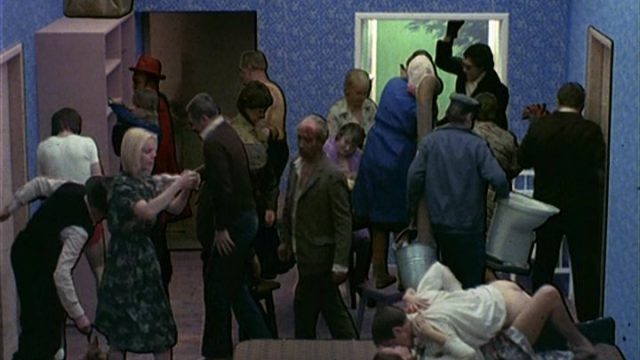More Polish filmmaking fun!
Content warning: Nudity and some gettin’ frisky ahead.
Tango (1981) dir. Zbigniew Rybczyński
This hypnotic piece only grows more complex the more you try to keep track of everything going on, even though each piece is on a short loop. Imagining the process of making it in a pre-digital era is even more difficult. According to Rybczyński, it took him over seven months of sixteen-hour days to produce the 16,000 mattes around each character and hundreds of thousands of exposures through an optical printer to transfer these images into the same scene. He’s proud that he “made less than one hundred mathematical mistakes out of several hundred thousand possibilities,” though he still bemoans the flaws caused by the technology including the dark edges of the mattes and the inevitable grime introduced when working with the same physical prints over and over.
Flaws notwithstanding, this won the Oscar for short animation at the 1983 ceremony, resulting in one of the most ignominious acceptances in the history of the award. After having his name twice butchered by presenter Kristy McNichol, his translated speech cut short by the orchestra, forcing his way back to the podium, then feeling the need to explain an attempted kiss for McNichol before finishing his speech to chuckles throughout the audience, Rybczyński went outside for a smoke and was subsequently denied re-entry by a security guard despite the just-won Oscar still in his hands. The dispute became physical. A responding police officer did not take kindly to Rybczyński’s presentation of his case (yelling “American pig, I have Oscar!” and attempting to kick him in the balls), and Rybczyński spent the remainder of the ceremony in jail. The district attorney’s office did not prosecute, citing the language barrier. It appears alcohol may also have been a factor.
Rybczyński would continue to work on his English and, more importantly, the limitations of the technology that vexed him in the details of “Tango.”
Imagine (1986)
After emigrating to the United States during the period of martial law in early-80s Poland, Rybczyński became well-known for his shorts and particularly his music videos, having much better experiences attending ceremonies for the MTV Video Music Awards. He was also a pioneer in HD video, experimenting with and patenting technology still in use today. The “Imagine” clip above was produced as a demonstration of new HD technology, one of the first examples of high-definition filming in the United States and created well over a decade before it would be available to the general public.
Like “Tango,” the short is overlapping vignettes in a seemingly single setting, though this time the point of view moves laterally along a continuous set of identical rooms. I don’t know the exact methods used here, but I’m guessing a rotating set was involved, meaning he’s using a fixed camera again. The New York skyline out the window is composited in, but instead of the painstaking matting process of “Tango,” greenscreen was available for a much more seamless effect. There’s standard-def scans available online for comparison, but one can imagine how striking the clarity was compared to contemporary televisions.
Rybczyński, age 74, is still in the game, currently raising money for a new feature about a war veteran and a mafia princess navigating a drug deal. Investment opportunities are available.

